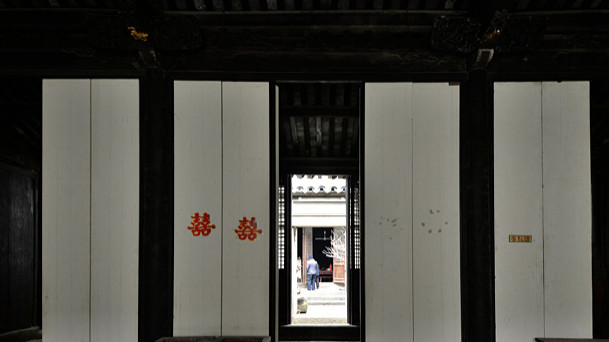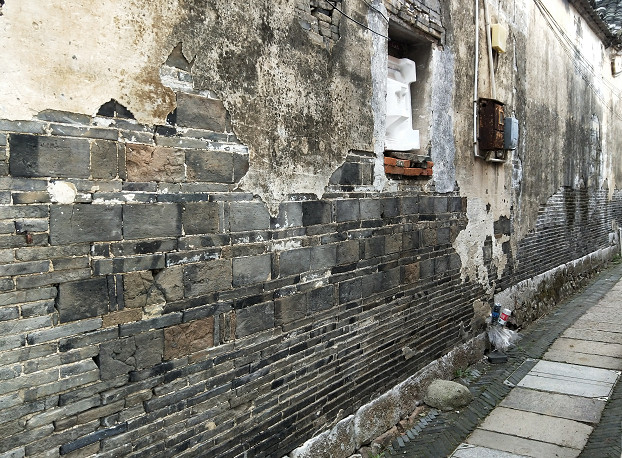East Village, where Qianlong's golden house hid beauties-Suzhou 3rd (10)
★ Tourist location: Ancient Village, East Village, West Mountain, Suzhou
When I went to East Village, I always thought that the so-called East Village was in the east of Xishan Island. Later, when I looked at the map, I realized that this was not the case at all. The East Village is located north of Xishan Island!

"This name is too confusing!" I murmured.
In fact, this is also because I am too ignorant. The word "East" in Dongcun does not refer to the direction, but refers to Tang Bing, the eldest of the famous hermit Shangshan Sihao in the late Qin and early Han Dynasties, from Shangqiu in Henan Province, known as Dongyuan Gong. Because he once lived in seclusion here, he was named Dongyuan Village. As he called out, he was called Dongcun Village. His full name was Dongcun Village. It developed into Xiaoji Town in the late Qing Dynasty and the early Republic of China, which was still relatively lively at that time. If this history is true, it has been at least more than 2,000 years since East Village was established? It seems that the chessboard stone on Ethereal Peak seems to have supporting evidence. After all, Duke Dongyuan lived in seclusion here, and it was not necessarily impossible for the other three "younger brothers" to visit their "older brothers" and play a game of chess at the highest peak of the 72 peaks.

After having enough food and tea, we certainly have the leisure to visit this ancient village. I originally thought it was an old village that had been renovated, but who knew that when I walked in, I realized that it was not the case. The road of stone slabs and blue bricks seemed to stretch time and suddenly brought us to the late Qing Dynasty and the early Republic of China. The ancient houses on both sides are mostly Qing Dynasty buildings, basically belonging to the Qianlong and Jiaqing periods, with about 20 buildings.
East Village does not welcome many tourists during the off-season of tourism, and the village seems relatively depressed in winter. The dog-tail grass danced randomly in the wind. Across the withered grass were houses with white walls and black tiles. Behind them were lush green mountains. The levels were still very beautiful. If some red maples are planted in the middle, the colors will be even more colorful.

We parked our car at the entrance of Taihu Lake. We walked into the village and found that there was also a parking lot inside. However, it was not big. It shows that even in the peak season, there would not be too many tourists. After all, there are relatively famous ancient villages in Dongshan and Xishan. Dongshan is Luxiang Village, and Dongcun is Mingyue Bay. If there is not enough time, ordinary people will not include East Village in their itinerary list.

Since it is an ancient village, there are naturally ancient trees. The two camphor trees at the entrance of the village seem to be old, at least a few hundred years old? The bottom of the tree trunk has been emptied by the column. Filling it with cement will not affect the beauty of the tree.

On the west side of the ancient village, there is an ancestral temple of the Xu family. It was built in the 13th year of Qianlong of the Qing Dynasty. It was created by the famous Confucian merchant Xu Lianxi. After the Cultural Revolution in the last century, it was converted into a primary school, a village-run factory and a village committee office. The original scale is quite considerable, with an area of 1,000 square meters. But now only the front hall is the original building, with exquisite wood carvings, brick carvings, stone carvings and Soviet-style paintings. However, because there are two carved buildings in Dongshan and Xishan that are especially beautiful, ordinary carvings cannot arouse people's amazement.

The most famous ancient building is Jingxiu Hall, also known as the "Golden House Hidden Beauty". It is said that when Qianlong went to Jiangnan three hundred years ago, he went to the East Village of Xishan Mountain and took a fancy to a beautiful girl, and held a ceremony solemnly in accordance with the Han Chinese ceremony. However, this romantic emperor also knew many rules of being an emperor. Han people could not enter the palace, so he could only arrange to stay in Jingxiu Hall in East Village. From then on, she hid beauties in the golden house. This girl was quite poor. She thought she had found a wonderful man for her life, but in the end, this wonderful man's political status was really too high. Although she was grateful to Chu Fen when she entered the palace, she still had some hope. Living in Jingxiutang, it was not easy for the emperor to go south next time. He could only meet once every few years, and he could only stay alone in the vacant room.

Jingxiutang is also the filming place for TV series such as "Oranges Are Red","Woman in the Courtyard", and "Wind and Rain Carved Building". Different from the general residential pattern that faces south, the gate of Jingxiu Hall faces east. Covering an area of 1866 square meters, it is the largest existing ancient house in Xishan. The property rights are shared by more than ten villagers, and villagers still live there.

There are six entrances in the entire building from the door room to the miscellaneous room, and there are a total of three brick gate buildings, which is also the more valuable place of the ancient house. The last entrance is called Fengqi Building, with five rooms and two floors, which is probably the place where beauties are hidden. What is more outstanding is the twelve floor-to-ceiling long windows downstairs. Each long window is carved with a different shaped dragon, representing the twelve months. Because the emperor was the real dragon and the son of heaven in feudal times, only the emperor could use dragons, especially the five-clawed dragon, which symbolized the real dragon and the son of heaven. There are such carvings on the two floor-to-ceiling windows in the hall. It can be said that this is the unique carving among ancient houses and houses.

In addition to the main street, there are many alleys, including an alley gate at the entrance of "Qixian Lane". It seems that this alley should have some story. This alley gate itself is also a provincial-level cultural relic protection unit, and is said to be entirely made of nanmu.

The mottled walls bear witness to the ups and downs this ancient village has experienced. Especially because there are no tourists, walking on the cold stone road has its own tranquility that is not found in the streets and alleys of other ancient towns. Here, you can travel into ancient times without worrying about being awakened by incoming tourists. Oh, what finally woke me up was a tabby cat. When we walked back from the back alley, it followed us step by step until the entrance of the village.













Previous Article:How does Suzhou escape heat in summer? Visiting mountains, rivers and gardens, here is the most comprehensive travel guide
